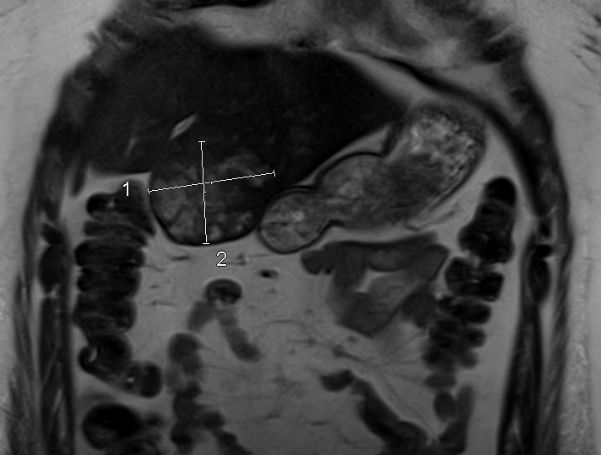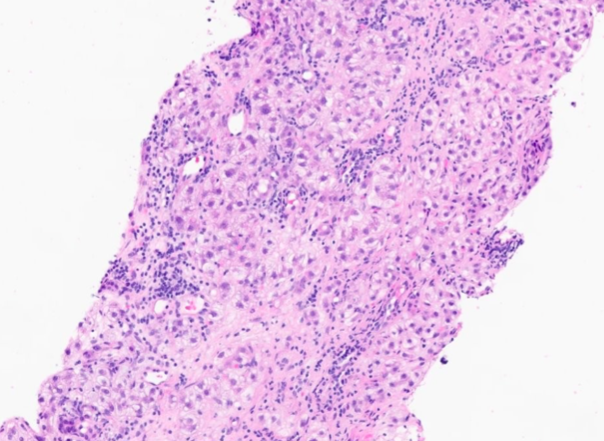Monday Poster Session
Category: Liver
P3848 - A Rare Case of Clear Cell Variant of Hepatocellular Carcinoma in a 20-Year-Old Woman With Neurodevelopmental Disorders
Monday, October 27, 2025
10:30 AM - 4:00 PM PDT
Location: Exhibit Hall

Naga Vamsi Krishna Machineni, MD (he/him/his)
Appalachian Regional Healthcare
Harlan, KY
Presenting Author(s)
Naga Vamsi Krishna Machineni, MD1, Midila Bapineni, MD1, Bradley Gibson, MD2, Stephen James Mularz, DO3
1Appalachian Regional Healthcare, Harlan, KY; 2PATHOLOGY & CYTOLOGY LABORATORIES, Lexington, KY; 3Appalachian Regional Healthcare, Hazard, KY
Introduction: Hepatocellular carcinoma (HCC) is the most common primary liver malignancy in adults but is exceedingly rare in young individuals without underlying liver disease. The clear cell variant of HCC, a histologic subtype characterized by abundant clear cytoplasm, accounts for only 7–12% of HCC cases and typically presents in older adults, with a median age of diagnosis between 60–69 years. We present a unique case of clear cell HCC in a 20-year-old female with no known hepatic risk factors.
Case Description/
Methods: A 20-year-old female with a history of bipolar disorder, intellectual disability, autism spectrum disorder, and chronic constipation presented with a two-year history of epigastric burning and generalized abdominal pain which is associated with nausea and rectal bleeding for the last two months. Prior colonoscopy was unremarkable. Repeat EGD revealed bile reflux gastritis; colonoscopy identified a rectal polyp with otherwise normal mucosal biopsies.
Laboratory workup, including viral hepatitis panel, autoimmune markers, and liver function tests, was unremarkable except for mildly elevated alkaline phosphatase. Imaging (CT and MRI) revealed a 6.4 x 4.2 cm heterogeneously enhancing hepatic mass [1]. Ultrasound-guided Liver biopsy confirmed a well-differentiated hepatocellular carcinoma without fibrolamellar features. Histologic examination showed a well-differentiated hepatocellular neoplasm with clear cell cytologic features [2]. Glutamine synthetase immunohistochemistry shows patchy positivity without any diffuse reactivity or map-like appearance. Given the clinical presentation and supporting findings, the diagnosis of hepatocellular carcinoma was established. The patient was referred for hepatic lobectomy.
Discussion: Pediatric and adolescent HCC is rare and often lacks identifiable risk factors. Clear cell HCC, while associated with a better prognosis, is rarely reported in this age group and more commonly affects older women. The presence of neurodevelopmental disorders may have contributed to delayed symptom recognition and diagnosis.
HCC, particularly the clear cell variant, is sporadic in this demographic and can easily be overlooked. This case also highlights the need for heightened clinical vigilance in patients with neurodevelopmental disorders, where symptom reporting may be limited or atypical.This case underscores the diagnostic challenge of HCC in a young adult without cirrhosis, viral hepatitis, or metabolic liver disease.

Figure: 1. MRI of the abdomen with contrast revealed a 6.4 x 4.2 cm heterogeneously enhancing hepatic mass

Figure: 2. H&E-stain: hepatocytes with diffuse clear cell changes, anisocytosis, admixed chronic inflammation, and an absence of portal tracts.
Disclosures:
Naga Vamsi Krishna Machineni indicated no relevant financial relationships.
Midila Bapineni indicated no relevant financial relationships.
Bradley Gibson indicated no relevant financial relationships.
Stephen James Mularz indicated no relevant financial relationships.
Naga Vamsi Krishna Machineni, MD1, Midila Bapineni, MD1, Bradley Gibson, MD2, Stephen James Mularz, DO3. P3848 - A Rare Case of Clear Cell Variant of Hepatocellular Carcinoma in a 20-Year-Old Woman With Neurodevelopmental Disorders, ACG 2025 Annual Scientific Meeting Abstracts. Phoenix, AZ: American College of Gastroenterology.
1Appalachian Regional Healthcare, Harlan, KY; 2PATHOLOGY & CYTOLOGY LABORATORIES, Lexington, KY; 3Appalachian Regional Healthcare, Hazard, KY
Introduction: Hepatocellular carcinoma (HCC) is the most common primary liver malignancy in adults but is exceedingly rare in young individuals without underlying liver disease. The clear cell variant of HCC, a histologic subtype characterized by abundant clear cytoplasm, accounts for only 7–12% of HCC cases and typically presents in older adults, with a median age of diagnosis between 60–69 years. We present a unique case of clear cell HCC in a 20-year-old female with no known hepatic risk factors.
Case Description/
Methods: A 20-year-old female with a history of bipolar disorder, intellectual disability, autism spectrum disorder, and chronic constipation presented with a two-year history of epigastric burning and generalized abdominal pain which is associated with nausea and rectal bleeding for the last two months. Prior colonoscopy was unremarkable. Repeat EGD revealed bile reflux gastritis; colonoscopy identified a rectal polyp with otherwise normal mucosal biopsies.
Laboratory workup, including viral hepatitis panel, autoimmune markers, and liver function tests, was unremarkable except for mildly elevated alkaline phosphatase. Imaging (CT and MRI) revealed a 6.4 x 4.2 cm heterogeneously enhancing hepatic mass [1]. Ultrasound-guided Liver biopsy confirmed a well-differentiated hepatocellular carcinoma without fibrolamellar features. Histologic examination showed a well-differentiated hepatocellular neoplasm with clear cell cytologic features [2]. Glutamine synthetase immunohistochemistry shows patchy positivity without any diffuse reactivity or map-like appearance. Given the clinical presentation and supporting findings, the diagnosis of hepatocellular carcinoma was established. The patient was referred for hepatic lobectomy.
Discussion: Pediatric and adolescent HCC is rare and often lacks identifiable risk factors. Clear cell HCC, while associated with a better prognosis, is rarely reported in this age group and more commonly affects older women. The presence of neurodevelopmental disorders may have contributed to delayed symptom recognition and diagnosis.
HCC, particularly the clear cell variant, is sporadic in this demographic and can easily be overlooked. This case also highlights the need for heightened clinical vigilance in patients with neurodevelopmental disorders, where symptom reporting may be limited or atypical.This case underscores the diagnostic challenge of HCC in a young adult without cirrhosis, viral hepatitis, or metabolic liver disease.

Figure: 1. MRI of the abdomen with contrast revealed a 6.4 x 4.2 cm heterogeneously enhancing hepatic mass

Figure: 2. H&E-stain: hepatocytes with diffuse clear cell changes, anisocytosis, admixed chronic inflammation, and an absence of portal tracts.
Disclosures:
Naga Vamsi Krishna Machineni indicated no relevant financial relationships.
Midila Bapineni indicated no relevant financial relationships.
Bradley Gibson indicated no relevant financial relationships.
Stephen James Mularz indicated no relevant financial relationships.
Naga Vamsi Krishna Machineni, MD1, Midila Bapineni, MD1, Bradley Gibson, MD2, Stephen James Mularz, DO3. P3848 - A Rare Case of Clear Cell Variant of Hepatocellular Carcinoma in a 20-Year-Old Woman With Neurodevelopmental Disorders, ACG 2025 Annual Scientific Meeting Abstracts. Phoenix, AZ: American College of Gastroenterology.
